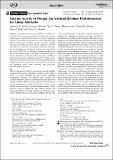Files in this item
Enzyme activity by design : an artificial rhodium hydroformylase for linear aldehydes
Item metadata
| dc.contributor.author | Jarvis, Amanda | |
| dc.contributor.author | Obrecht, Lorenz | |
| dc.contributor.author | Deuss, Peter | |
| dc.contributor.author | Laan, Wouter | |
| dc.contributor.author | Gibson, Emma K. | |
| dc.contributor.author | Wells, Peter P. | |
| dc.contributor.author | Kamer, Paul C J | |
| dc.date.accessioned | 2017-10-09T15:30:12Z | |
| dc.date.available | 2017-10-09T15:30:12Z | |
| dc.date.issued | 2017-10-23 | |
| dc.identifier | 250874289 | |
| dc.identifier | ad037756-dba6-4e29-b399-311316bfb3e7 | |
| dc.identifier | 85029357065 | |
| dc.identifier | 000413314800005 | |
| dc.identifier.citation | Jarvis , A , Obrecht , L , Deuss , P , Laan , W , Gibson , E K , Wells , P P & Kamer , P C J 2017 , ' Enzyme activity by design : an artificial rhodium hydroformylase for linear aldehydes ' , Angewandte Chemie , vol. 129 , no. 44 , pp. 13784-13788 . https://doi.org/10.1002/ange.201705753 | en |
| dc.identifier.issn | 0044-8249 | |
| dc.identifier.uri | https://hdl.handle.net/10023/11820 | |
| dc.description | Funding: Marie Curie Individual Fellowship project ArtOxiZymes to AGJ (contract no. H2020-MSCA-IF-2014-657755), EPSRC Critical mass grant ‘Clean catalysis for sustainable development’ (EP/J018139/1) and Sasol (CASE studentship to P.J.D.), EPSRC (EP/K014854/1). | en |
| dc.description.abstract | Artificial metalloenzymes (ArMs) are hybrid catalysts that offer a unique opportunity to combine the superior performance of natural protein structures with the unnatural reactivity of transition-metal catalytic centers. Therefore, they provide the prospect of highly selective and active catalytic chemical conversions for which natural enzymes are unavailable. Herein, we show how by rationally combining robust site-specific phosphine bioconjugation methods and a lipid-binding protein (SCP-2L), an artificial rhodium hydroformylase was developed that displays remarkable activities and selectivities for the biphasic production of long-chain linear aldehydes under benign aqueous conditions. Overall, this study demonstrates that judiciously chosen protein-binding scaffolds can be adapted to obtain metalloenzymes that provide the reactivity of the introduced metal center combined with specifically intended product selectivity. | |
| dc.format.extent | 1155391 | |
| dc.language.iso | eng | |
| dc.relation.ispartof | Angewandte Chemie | en |
| dc.subject | Artificial metalloenzymes | en |
| dc.subject | Catalyst design | en |
| dc.subject | Hydroformylation | en |
| dc.subject | Phosphines | en |
| dc.subject | Rhodium | en |
| dc.subject | QD Chemistry | en |
| dc.subject | QH301 Biology | en |
| dc.subject | NDAS | en |
| dc.subject.lcc | QD | en |
| dc.subject.lcc | QH301 | en |
| dc.title | Enzyme activity by design : an artificial rhodium hydroformylase for linear aldehydes | en |
| dc.type | Journal article | en |
| dc.contributor.sponsor | EPSRC | en |
| dc.contributor.institution | University of St Andrews. School of Chemistry | en |
| dc.contributor.institution | University of St Andrews. EaSTCHEM | en |
| dc.identifier.doi | https://doi.org/10.1002/ange.201705753 | |
| dc.description.status | Peer reviewed | en |
| dc.identifier.url | http://onlinelibrary.wiley.com/doi/10.1002/ange.201705753/full#footer-support-info | en |
| dc.identifier.grantnumber | EP/J018139/1 | en |
This item appears in the following Collection(s)
Items in the St Andrews Research Repository are protected by copyright, with all rights reserved, unless otherwise indicated.

